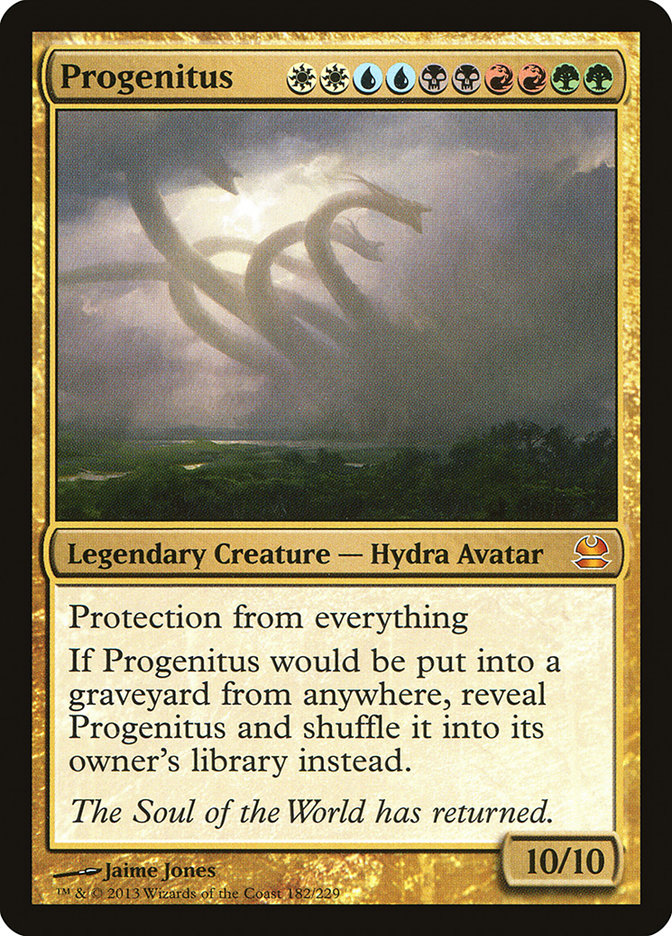Dear Azami, I like to make Commander decks that embody the spirit of Commander games rather than ones that simply just win and make it not fun. I’ve gotten game stores to start a Commander League and enjoy toting my fourteen-plus decks around to introduce new players to the game. My favorite deck was actually one on your suggestions, a Mishra deck centered on Possibility Storm (I took out the Hive Mind and Eternal Dominion combo after getting it off once). And now comes the deck that is set to have a fun theme but which I’m having a problem with execution: Gods. They’re on everyone’s mind. It’s still too early to actually playtest this, but I’ve been working on assembling a team of foil Gods just to say to my players “are you a god?” This was originally going to be a “cycle” deck with cards that come in a cycle of five (primordials, myojin, titans, etc.). So here’s the rub: I know the creature base despite not knowing what five creatures will do for the game (it can be assumed that they will be indestructible, require devotion, and have an ability). I’m less sure that I know the mana base because I always have a little trouble with this part (do I add in the Alara tri lands, do I take out the Guildgates, should I actually run some basics in case the world burns?). What I don’t know is the other third of the deck. I need something that will help turn the Gods on, fetch them out, and fit with the theme. Having never built an enchantment theme deck before, I thought I’d turn to the experts. From my first build, I have 95 cards (which is assuming I can count properly), but I’m not sure if I’m too on theme to actually have a way to win. Also, I’m not set on the commander itself yet. I’m leaning toward Progenitus (since I have a foil one), but I know that Karona, False God will be in the deck and might be a better commander. Any suggestions on that one while you’re at it? Help is greatly appreciated, and you guys are the best. God Creatures (15) Athereos Heliod, God of the Sun Gods That Aren’t Gods (7) Karona, False God Demigods (10) Overbeing of Myth Other Spells (27) Dominaria’s Judgment Lands (36) Temple of Abandon |
The new Gods are on everybody’s mind—we’ve basically had three God-centered decks in a row, though Cassidy was classy enough upon his return to just think “Xenagos, God of Revels!” very loudly and not swap a years-old Stonebrow deck’s commander out for the shiny new thing. The Gods are so on your mind though that you’ve accepted five blank placeholders as you build your deck, and crazy though that may sound, that’s what got me to pick your deck since we can build it now and see just what all of it does later on down the line. Sometimes, just sometimes, we Embrace a little Chaos too here on Dear Azami.
The choices you’ve offered me at the helm here are Progenitus—the Soul of the World, if you remember the lore—and Karona, False God. Only one of the two can correctly answer the simple question “are you a god?” (Hint: when someone asks “are you a god?” you say yes.) Karona says it right there—she’s a false god—so we’re going to build this monster with Progenitus and take advantage of the fact that whatever these new Gods we know nothing about do Progenitus will always count for four pips of devotion. That may not be necessary—your complete cycle of demigods is actually quite good at turning on devotion by themselves—but it’s still an attractive selling point nonetheless.
And it’s lucky I guess that you got me rather than Cassidy—Cassidy is no slouch, but I come to the casual side of things here with a long pedigree of competitive play and deckbuilding analysis. After I don’t even remember how many years of writing the column Magical Hack for StarCityGames.com, let’s just say if there is at least one thing I know right it’s how to build a man abase. I am going to come at this with a chainsaw, but in the end everything will work better. I promise.
Huge Tracts Of Land
We’ll be cutting out two cycles and adding in three more cycles plus a weird semi-cycle that will prove quite useful as well. The cuts are going to be the Temples and Guildgates—we’re just going to have a higher standard for lands that come into play tapped. The Guildgates don’t provide very much benefit at all without that Maze’s End, and as good as the Temples are, I’m not drawn to any specific color pair and to playing all ten of them. The semi-card advantage offered by the scry effect can be replaced with a more nearly card-advantage-like cycle of lands by adding the Ravnica Block bounce lands instead, so that’s just what we’re going to do. Maze’s End also gets cut with the ten Guildgates, freeing up eleven slots instead of ten.
We’re also going to cut out Urborg, Tomb of Yawgmoth, and given how much colored mana you need for most of your cards, I really want to cut Temple of the False God as well. I’m going to make a lot of concessions to theme and style to make this deck as God-smacked as we can, but at least as far as the mana base is concerned. I’m going to rely first and foremost on setting the deck up properly before conceding to theme. You can’t use the Temple for Progenitus, and it doesn’t help with any of your Deities. Plus at least to date all of your Gods can be cast for five or less, so this “accelerating” you to six off of your fifth land drop doesn’t really help.
Out: Temple of Abandon, Temple of Deceit, Temple of Enlightenment, Temple of Malice, Temple of Mystery, Temple of Plenty, Temple of Silence, Temple of Triumph, Temple of Keranos, Temple of Pharika, Azorius Guildgate, Boros Guildgate, Dimir Guildgate, Golgari Guildgate, Gruul Guildgate, Izzet Guildgate, Orzhov Guildgate, Rakdos Guildgate, Selesnya Guildgate, Simic Guildgate, Maze’s End, Urborg, Tomb of Yawgmoth, Temple of the False God
In: Azorius Chancery, Boros Garrison, Dimir Aqueduct, Golgari Rot Farm, Gruul Turf, Izzet Boilerworks, Orzhov Basilica, Rakdos Carnarium, Simic Growth Chamber
We’ve got thirteen slots as yet unfilled, and I know from looking at this build (and from experience playing all ten bounce lands in a five-color deck) that you’re going to want more than 36 lands. I really want 38 here, cutting some of your land search cards to just play lands instead. I don’t see much need for mana acceleration in a deck that is pretty low on the curve like this one is, and there is a clear innate ability to hit the higher reaches of the mana curve naturally when you play this many bounce lands in a deck, which makes additional ramp effects less necessary. So that gives us fifteen slots left to fill, not just the thirteen vacated by cuts.
In: Savage Lands, Crumbling Necropolis, Arcane Sanctum, Seaside Citadel, Jungle Shrine
Coming into play tapped is a significant cost, especially when the land to follow it is a bounce land. This is where the lands that start play tapped will end then, and we’re extending to include them in the first place based solely on how strong these tricolored lands are in a deck that is evenly spread across all five colors but has a variety of intense mana costs. Each of these will tap for at least one of the right colors for nine out of ten demigods, meaning they’re exactly right for this deck’s particular needs. While I’ve gone in different directions in the past when trying to build a five-color mana base for different decks, for this one I think this cycle is particularly important.
In: Darkwater Catacombs, Shadowblood Ridge, Mossfire Valley, Sungrass Prairie, Skycloud Expanse
This cycle is also very strong, as you don’t have to have either of these colors in order to generate both of them at the same time. Ephara can be cast off of three colorless lands plus a Skycloud Expanse, which means that we can be a lot less particular about lining up the right lands next to each other since these will always work.
In: Command Tower, Reflecting Pool, Forbidden Orchard, Exotic Orchard
This is the semi-cycle I was referring to, tying the two Orchards together and then considering the Pool to be just a different version of the Orchard. What they are effectively are five-color lands for our five-color deck. Each of them has different trigger conditions or costs in order to get there, and obviously Command Tower is the easiest to appease since it’s defined by Progenitus at the helm. But in your average game each of these should tap for whatever colored mana you need without much of an interruption or cost associated to them. Sometimes you’ll care about giving someone a 1/1, but overwhelmingly you won’t because a 1/1 token is of little relevance. If anything it can always be a political bonus, tapping to generate a would-be ally a chump blocker.
This is my favorite land in the format, even more so than Winding Canyons because it is a Winding Canyons amped up to the next level. It’s color specific, yes, but it makes up for that by letting you do whatever you want whenever you want to, accomplishing all sorts of shenanigans at a time of your choosing. As the deck ends up quite sorcery speed overall, this is an important counterbalance to the problem that many of your cards only play on your own turn.
With the lands completed, we move next to your creatures and make no changes. Everything here is present for thematic reasons, and this is the heart of the deck. I gave some consideration toward using the five empty slots left in the deck on the cycle of bringers, but as awesome as Bringer of the Blue Dawn is, they’re not god touched in any way and would just be us playing a neat five-color card because we’re allowed to. So I left this section entirely as is and then made only minor cosmetic changes to the artifacts, cutting Darksteel Ingot, Fist of Suns, and Quicksilver Amulet from the deck and making just one replacement using the two empty slots on the lands we added and thus having five slots left unfilled as we look at the spells.
Darksteel Ingot is definitely defensible for this deck, but I don’t really see the ramp as necessary for it since the casting costs of your cards are so low overall. I like Chromatic Lantern because of the ability it grafts onto your lands, not because it taps for mana itself, and in fact would have added it even as I cut other ramp cards if you didn’t already have it. Darksteel Ingot is reliable and highly effective but not actually a card of relevance or interest to us.
The other two got cut because they aren’t really helping. Five mana is the top threshold for creatures we want to cheat into play off the Amulet so we might as well just cast them, and being able to substitute five hybrid-colored mana on a demigod for WUBRG instead is not really an upgrade I’m interested in making. While the Fist does enable the Myojin to function a little more consistently, I don’t want to use the slot on making just five of our cards work a little better when we can’t also set things up to draw them more consistently. It’s at best a minor focus and one that is already answered by adding bounce lands—we’ll hit the eight to ten mana range more easily thanks to the fixes we’ve made to the deck’s mana base, so these enablers are just no longer necessary.
And the addition we make to the deck in order to fill that last slot happens to work excellently with our bounce lands. Seer’s Sundial is a solid card-drawing mechanism, and I think we’re definitely interested in more ways to draw additional cards so I’ve added it to the deck and put an asterisk next to it to remind me that I want to find more ways to draw additional cards. Solid as the Gods and demigods are, if you’re just drawing one card a turn, they’re still going to need help to overwhelm an opponent.
Divine Incantations
We have five slots and plenty of cuts to make here. I don’t consider any of these slots to be sacrosanct unlike the creature core that I see as the thematic heart of the deck, so it would actually be a shorter story to cut everything and keep the six cards I do want: Wrath of God, Enduring Ideal, Mirari’s Wake, Descendants’ Path, Asceticism, and Burgeoning. Wrath of God gets to stay because, duh, it references god—if you hadn’t already included it, I was going to regardless of actual function since this deck should be as flavor drenched as we can plausibly make it.
Mirari’s Wake is a “good stuff” card, but I like the enchantment theme and thus am content to let it stay because I will be seeking to build that enchantment theme up even further, not tear it down. Enduring Ideal is dangerous and at least a little sketchy, but I like the idea of playing up the enchantment theme enough that the somewhat suicidal epic spell makes me happy rather than sad. With all of these enchantment creatures being valid targets to pull out with the Ideal and Xenagos potentially supercharging them all hastily into the red zone, I’m down to see what happens because the stories alone will be worth it. And we’ll build the enchantment theme up further from here to make those stories happen more often.
Descendants’ Path gets to stay because Gods should beget more of themselves, and while it would be far better with Sensei’s Divining Top, I didn’t think it was the most necessary or relevant addition. If I felt I could mess with the purity of the creature base at all, I probably would have added Trinket Mage to find the surprisingly awesome Amulet of Vigor for this deck and serve as another way to find the Divining Top besides, but we’ll have to leave it to chance and the top of the deck to make that happen.
We’ll have an enchantment that works with it added in here at the end, but we aren’t really aiming to maximize this, just mise off of it sometimes for free. If I were going to mess with the creature slots it would begin by adding the two Eldrazi we’re allowed to play because the Old Ones would serve as quite Lovecraftian additions to your pantheon of gods here, but as they’re now swinging into the $40 or $50 range, I think we’ve been effectively priced out of their “casual” addition here at Dear Azami.
Asceticism is actually a religious reference and gets to stay regardless of whether I particularly like the card (I don’t) because it fits the overarching flavor theme and we’re building this as a Vorthos deck, not a Johnny one. And Burgeoning, well, it happens to be exceptionally awesome with your bounce-land-centered mana base in addition to being a sweet card to add to a Commander deck in general. I don’t usually play it because it’s a bit over the top of where I want to play power-wise since I see it as almost as good as the deservedly banned Fastbond, but I won’t cut it out of the deck after adding ten lands that bounce a land back to your hand. You could quite plausibly just have land drops forever and get up to ten or twelve mana off of an otherwise clunky looking hand if that hand happens to include Burgeoning.
Everything else gets cut. We don’t need the mana ramp and fixing, and I really dislike the Hondens for your deck. Good though Damnation may be, it references the devil, not any particular god. We’re going to want more sweepers, yes, but we’re also going to want to hit more things with our sweepers, so even as I cut this I know we’re going to end up with more than the two sweepers you started with. They just aren’t going to be this particular one you had.
This gives me a total of 21 slots to fill in, and I want to build up some additional layers of defense; bolster the deck’s card-drawing capabilities; and work on theme, theme, theme. I won’t be happy til we’re positively dripping with flavor, which means the first five additions are easy:
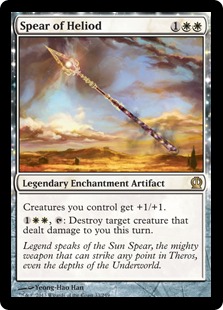

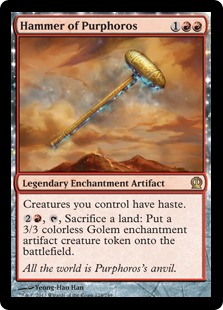
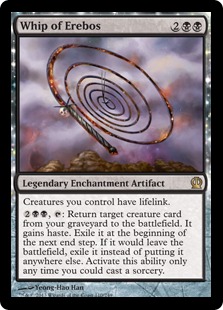
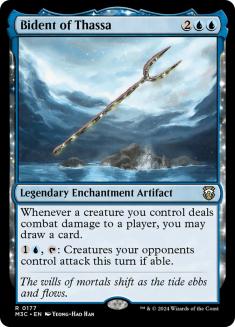
We are God heavy, and while I hated the Hondens that are supposed to “reference” the godlike Myojin you’re already playing, I love the feel these add to the deck and the bonuses as well. They add a varied shade of benefits to the deck with their static abilities, and all but the Hammer have an ability tacked on that is awesome in multiplayer play (one way or the other).
Bident of Thassa has probably never been activated in Mono-Blue Devotion despite being a marquee card in the deck; it’s used for its Coastal Piracy impression rather than the forced attack aspect of the card, but there is something decidedly alluring to its Siren’s Call here, while the applications of the other three are more straightforward and obvious. Between them and the five monocolored Gods themselves, you’re going to be sharing a lot of ability text amongst your creature base, and I like the way they lend flavor and theme at the same time as they provide gameplay and bonuses to the scion of the Gods you’ve elected to play with.
Let’s work on the card-drawing aspect of the deck next, some of which will be on theme for the god aspect of the deck and others that are “just’ on theme for the enchantment nature of the deck.
Future Sight – Oracular ability is a storied ability of the Gods themselves, and this helps add to your card draw while adding to that flavor in at least an oblique fashion. This is also another argument against the inclusion of a Sensei’s Divining Top, as I absolutely hate the “accidental” combo of unlocking “1: Draw a card” and racing through your deck at clips of ten to twenty cards at a time.
Soothsaying – And this is what I opted to include instead of Sensei’s Divining Top, as it is a more flavorfully god-themed addition (and not just a cheaper one now that the Top is around $25 thanks to Legacy play). We’ve got a few cards this is particularly good with—Future Sight is one, as is Descendants’ Path—but it’s a solid Commander card given time and mana to work with and fits the flavor theme even if it’s a “substandard” Divining Top.
Mystic Remora – I wish I could stretch this to say it has deep mythological significance, but a remora is just a fish. The inclusion in Greek mythology is as an also ran, not a star player, so we’re playing this for the card draw primarily rather than any flavor to savor. For just a little bit of mana, this lets you draw a lot of cards off of opponents doing stuff; people will tend to slow down and pay one for your Rhystic Study, but four is way more than one so this usually results in a good chunk of drawn cards.
Rhystic Study – The thing itself. I don’t like this card and don’t play it myself, but this is the sort of deck it’s right for. You’ll either cause your opponents to slow down or draw a bunch of cards, either of which are an acceptable outcome.
Phyrexian Arena – Another Commander all-star for drawing cards off of enchantments. We’re enchantment themed thanks to our Gods and the desire to meet the necessary levels of devotion, but we would still be reaching for this card even if we didn’t specifically want enchantments as the source of our card draw benefits and were playing cards like Fact or Fiction instead.
Inheritance – Now, I can’t make that same claim for this one, but it is somewhat flavorful and does trigger a lot of times over the course of your average turn since creatures dying in Commander tends to happen by the bucketload. Every time a creature dies, you can spend three mana to draw a card, and we’ve added all of this extra mana capacity to the deck already without sinking it usefully into something.
I definitely see a lot of potential for this card despite the fact that people don’t really play it. Resource conversion cards are strong in this format, especially when they don’t require tapping in order to make the exchange and thus can trigger multiple times over the course of a turn. While Mind’s Eye may draw you more cards faster and cheaper, Mind’s Eye also gets killed basically every time you play it, while this can fly under the radar but still have the desired effect.
Enchantress’s Presence – We’re going to add enough enchantments overall (on top of your fifteen Gods) to make this a worthwhile investment. I keep thinking it is itself somehow a cantrip, but that is really neither here nor there. Every other enchantment you play following this one will be, and that will end up being a significant chunk of your deck.
Maelstrom Nexus – While this isn’t card draw per se, this was what I was thinking I would rather have when I cut Wild Pair from your deck. You don’t have countermagic so every cascade will be a live one, and this will let you do stuff like cast one God and cascade into another one or cast Nylea and cascade into her Bow. It’s only incremental card advantage, but it’s clearly strong enough to warrant the inclusion when you’re already enchantment themed.
Replenish – Not exactly card drawing—more like card recycling—but your deck has a lot of enchantments, and this will get all of them back if someone’s managed to take them out of play. While it’s true that a whopping fifteen of them are indestructible and thus you should expect them to be durable enough to stay in play, stuff like All Is Dust happens, and nothing is certain. With something like 30 or so enchantments in the deck total, this is going to let you r-buy spent cards en masse every time you’ve drawn it but shouldn’t be offensive like it usually is in a Commander deck since you’re just using it, not abusing it.
We’ve finished with the card-drawing aspects of the deck, so the remainder of the deck’s space will go towards defensive mechanisms that will help craft the way the deck plays. I really like sweeper effects with your indestructible creatures, especially now that we’re going to have various enchantments helping to bolster your devotion counts and thus not relying solely on the non-indestructible creatures like your demigods to let the Gods themselves swing in for damage. An indestructible team + sweeper effects is a great way to clear blockers, not just control the board, so I see this as potentially both an aggressive and a defensive line of play.

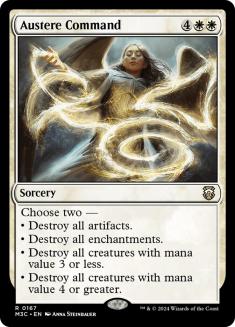
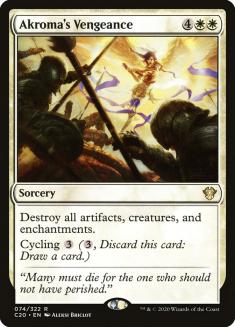
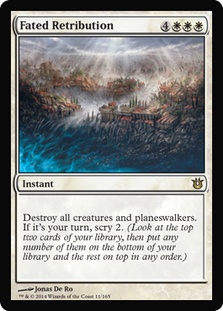
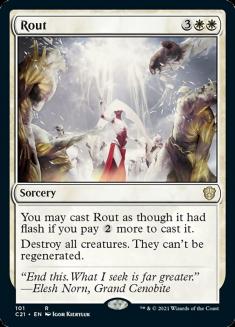
We’re relying on either the ability to sweep multiple types of permanents or the ability to be played at instant speed here to make these the right additions for the deck. Austere Command and Akroma’s Vengeance can both hit all sorts of permanent types, though one of them has considerably better aim than the other. Akroma’s Vengeance will blow up your card-drawing enchantments and your God-imbued stuff at the same time as everything else so it’s not exactly perfect here, while Austere Command sets modes very adeptly to hit exactly the right permanents that are problems to you right now and nothing else.
Fated Retribution also takes out planeswalkers, but that’s not as relevant to our interests here as the ability to play a sweeper effect at instant speed. Rout is basically perfect because it is exactly Wrath of God at instant speed and we’d rather add more sweepers that play at instant speed than pinpoint removal spells anyway. While I do like cards like Path to Exile and Swords to Plowshares, they’re “just” one-for-one removal to answer key problems, and with this many indestructible things to be left in play while you cast a sweeper, I’d rather pay a ton more and get a mass effect than save mana and get the more surgical tool.
Which is not to say I am against surgical tools in Commander. When building control decks, I like to include enough cheap removal spells to be confident I will draw one (and only one) over the course of a game so that I can always keep a mana up and be able to defend myself. Even better are the marginal cards that can do the same for free—Snuff Out, Slaughter Pact, and Submerge all remove a creature from play with zero mana invested in the effort upfront. However, this isn’t actually a control deck; this is a thematic midrange deck that will probably feel more aggro than control, with pillow fort mechanisms rather than board control mechanisms and overlapping beneficial effects being the way you take over a board.
So I don’t think those cards are the right tools here even though I think they’re excellent—strategically speaking you want to have just a few cards like this to take out piles of threats at a time but leave your board relatively intact, which these all do to varying degrees. While I think Akroma’s Vengeance is nearly so sloppy as to want to cut it, having added Replenish to the deck already I’m comfortable with it in the deck thanks to the power level. While it may kill an enchantment or three of yours, when you need it to kill seven or eight of an opponents’ enchantments, it’ll be a small price to pay to have an answer that gets everything no matter what.

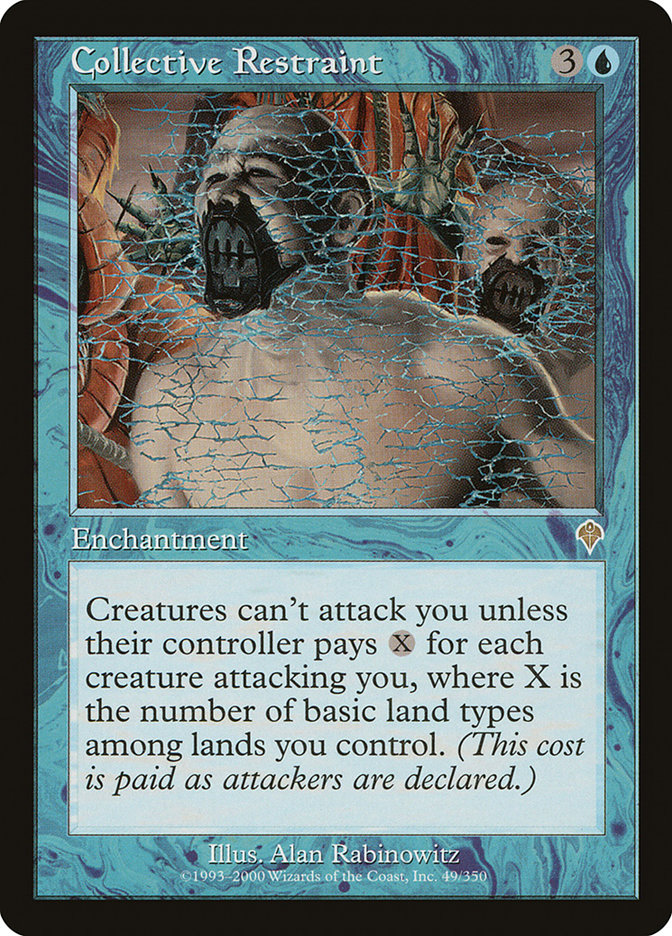
This is another class of cards I usually hate — the Propaganda effects — but I actually only hate the actual-Propaganda effects. Two is not really all that much mana to tack onto attacking you in this format even with a fair number of creatures, so I don’t see them as much more than political rattlesnakes that try to send an opponent in another direction but usually just emboldens them into actually paying the price to attack you just because you’re trying to divert them elsewhere.
Five is way more than two, and 35 is way more than two. Sphere of Safety has over a third of your deck contributing to that tax you levy against opposing attackers, making it quite a durable pillow fort indeed, while Collective Restraint can hit five mana instead of the paltry two that dissuades me from including Propaganda effects in the first place. While it is true that only ten of your lands have a basic land type at all and thus this can actually come down sometimes and have literally no effective text at all, any one land turns it into a Propaganda outright, and the second one will increase the tax to either three or four depending on whether the second land shares a color with the first one.
It’s quite reasonable to expect this to be online for four or five by the middle of the game, at which point it would meaningfully hamper your opponents’ ability to attack you effectively in the first place. Commander is a big mana format, so “only” being able to attack with six or seven creatures when you have Propaganda out is not actually a deterrent, but that same fourteen mana could account for just two creatures with Collective Restraint or actual zero with Sphere of Safety.
The last slot doesn’t really fit our themes directly, but it hits our Vorthos slot exactly right. We’ve made a few additions so far solely because of the god-themed aspect of the deck, and conviction is an emotion usually associated with religious zeal and fervor. It roughly translates to “the certainty of your faith,” with “faith in what?” usually being associated with a god or gods. (You can also have conviction without gods, but it’s not the typical use of the word in our common parlance no matter how hard the atheist movement may seek to reclaim it for themselves. “Faith in science” is kind of a contradiction in terms. You do the work behind the science to attain the belief; you don’t ascribe to it with “faith” at all.)
With a word search for religiously similar terms, I settled on True Conviction for the last addition since it fit the overarching themes while also kind of serving in the defensive role I wanted thanks to granting lifelink and thus bloating your life total as a means of defending yourself. It grants abilities that are useful to your creatures just like many of your Gods and their implements, works well toward devotion almost accidentally, and hits the enchantment theme of the deck as well. Flavor met function, so it seemed quite acceptable as the last addition to the deck.
Putting it all together, we get the following:
Commander
Lands (38)
Savage Lands
Crumbling Necropolis
Arcane Sanctum
Seaside Citadel
Jungle Shrine
Darkwater Catacombs
Shadowblood Ridge
Mossfire Valley
Sungrass Prairie
Skycloud Expanse
Hallowed Fountain
Sacred Foundry
Watery Grave
Overgrown Tomb
Stomping Ground
Steam Vents
Godless Shrine
Blood Crypt
Temple Garden
Breeding Pool
Azorius Chancery
Boros Garrison
Dimir Aqueduct
Golgari Rot Farm
Gruul Turf
Izzet Boilerworks
Orzhov Basilica
Rakdos Carnarium
Selesnya Sanctuary
Simic Growth Chamber
Command Tower
Nykthos, Shrine to Nyx
Exotic Orchard
Alchemist’s Refuge
Homeward Path
Cavern of Souls
Forbidden Orchard
Reflecting Pool
Artifacts (3)
Chromatic Lantern
Seer’s Sundial
Amulet of Vigor
Creatures (31)
Karona, False God
Myojin of Cleansing Fire
Myojin of Infinite Rage
Myojin of Life’s Web
Myojin of Night’s Reach
Myojin of Seeing Winds
Overbeing of Myth
Deus of Calamity
Demigod of Revenge
Oversoul of Dusk
Nobilis of War
Dominus of Fealty
Deity of Scars
Godhead of Awe
Ghastlord of Fugue
Divinity of Pride
Athereos, God of [Something]
Ephara, God of the Polis
Iroas, God of [Something]
Karametra, God of Harvests
Keranos, God of [Something]
Kruphix, God of [Something]
Mogis, God of Slaughter
Pharika, God of [Something]
Phenax, God of Deception
Xenagos, God of Revels
Heliod, God of the Sun
Thassa, God of the Sea
Erebos, God of the Dead
Purphoros, God of the Forge
Nylea, God of the Hunt
Instants & Sorceries (7)
Akroma’s Vengeance
Austere Command
Wrath of God
Rout
Fated Retribution
Enduring Ideal
Replenish
Enchantments (20)
Soothsaying
Mirari’s Wake
Collective Restraint
Sphere of Safety
Descendants’ Path
Asceticism
Maelstrom Nexus
Burgeoning
True Conviction
Future Sight
Spear of Heliod
Bow of Nylea
Hammer of Purphoros
Whip of Erebos
Bident of Thassa
Mystic Remora
Rhystic Study
Phyrexian Arena
Enchantress’s Presence
Inheritance
As always, for your participation in this week’s edition of Dear Azami, you will receive $20 store credit to StarCityGames.com, which should put a good dent in the price tag of $107.35 we ran up putting together the nearly 50 substitutions made to the deck. While we do have a few expensive cards, we averaged only $2.28 per card, and hopefully you’ll have some of the more common ones like Austere Command or Phyrexian Arena that are Commander staples and thus make it less expensive to change the deck into this form than that price tag suggests.
Breaking it down individually, the cards cost as follows:
Hopefully you’ve enjoyed the god-themed aspect of the deck, as it is now even more potently flavorful than it was before. While I think there are clear benefits to be gained adding Kozilek, Butcher of Truth and Ulamog, the Infinite Gyre to the deck as Lovecraftian “gods” as well, I can’t quite bring myself to suggest cards with that hefty a price tag just for a thematic fit. If you have them, by all means feel free to substitute them, as they’d be good additions and absolutely drip with Vorthos flavor. (They’d also make me have to question whether cutting Fist of Suns was correct, but I’d still do it even if I could cast an Eldrazi. After all, I can’t cast Emrakul in this format, so it’s less good here than in its recent breakout performance in Modern casting Eldrazi.)
— Sean McKeown
Want to submit a deck for consideration to Dear Azami? We’re always accepting deck submissions to consider for use in a future article, like Matt’s Stonebrow, Krosan Healer deck or Craig’s Rith, the Awakener deck. Only one deck submission will be chosen per article, but being selected for the next edition of Dear Azami includes not just deck advice but also a $20 coupon to StarCityGames.com!
Email us a deck submission using this link here!
Like what you’ve seen? Feel free to explore more of Dear Azami here! Be sure to follow Sean on Facebook; sometimes there are extra surprises and bonus content to be found over on his Facebook Fan Page, as well as previews of the next week’s column at the end of the week! Follow Cassidy on his Facebook page or check out his Commander blog GeneralDamageControl.com!

